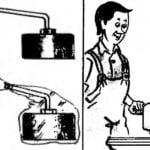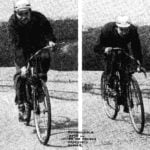 These beautiful and flying planes is very simple. They can do and the guys who have not yet engaged in aircraft modeling. To work they need a dense drawing paper (drawing paper), a few dry and straight straws Ø 2-2,5 mm (grasses, bluegrass, wild oat), silicate office glue. Also needed is a blade for a safety razor, jig saw, ruler and pencil.
These beautiful and flying planes is very simple. They can do and the guys who have not yet engaged in aircraft modeling. To work they need a dense drawing paper (drawing paper), a few dry and straight straws Ø 2-2,5 mm (grasses, bluegrass, wild oat), silicate office glue. Also needed is a blade for a safety razor, jig saw, ruler and pencil. The production models start with drawing on thick paper in full size it is necessary to draw all the parts and cut them out with scissors. Plywood of 3 mm thickness are cut in the cab weight. The wing is cut through along the dotted lines, bend the front edge and glue.
Now take two straws with a length of 130 mm, and in places the glue will scrape them with sandpaper sludge with a razor blade. Straws attach to the wing with the paper plates — clamps. Them to the straws glue the stabilizer.
The wing of a monoplane at the edges of the pads along the dotted lines fold 2 cm up. The ailerons are not cut, but only decorative labeling.
In the middle of the wing put a cabin-weights, which for strength laterally secure the paper corners. In the cockpit you can paste rear of the Plexiglas portholes. After Assembly, the glue must dry for 20-25 min.
Before starting the airplane on the stabilizer make two cuts, the surface between which fold up: get the Elevator. The ends of the stabilizer also folded along the dotted line to the vertical position. It will be Keeley. One of them incision — get the wheel turning.
The model can be turned and glider-biplane. For this we need to cut out another wing. Put him first and at the locations indicated by circles, pierce four holes in which to insert four straws stand a length of 30 mm. Ends, glue them to the top and bottom wings. If the counters extend up to 50 mm, easy to attach wheels, cut from paper, floats or skis from foam.
The monoplane, you can also implement two “jet engines”. They are made of glued paper on the pencil tubes with a length of 40 mm, which are placed under the wing on a paper the same brackets.
All these models fly well both indoors and outdoors. They perform some aerobatics (loop, Immelman, chandelle). With paper gliders can hold competitions on the range (monoplane flying almost 30 m) and accuracy landing.


The scheme and details of paper plane:
1 — light, 2 — cabin-Bob, 3 — wing, 4 — stabilizer, 5, 6 — brackets for “jet engines”, 7 — bracket for mounting the cab-sinker, 8 — pads-clamps for fastening of the stabilizer, 9 — pads-clamps to secure the wing, and 10 “jet engine”, 11 — skiing 12 — front wheel, 13 — wheel chassis.
M. PAKHOMOV, the instructor-trainer model airplanes



